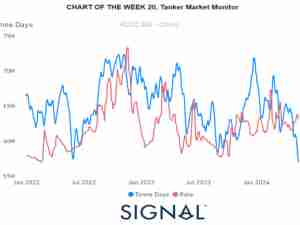Europe’s energy supply crisis has spread, not only geographically, but also across the energy complex. Record-high electricity and natural gas prices have not only knocked out fuel-intensive industry production but are creating fundamental knock-on effects on oil. We could see an additional oil demand boost of nearly 1 million barrels per day (bpd) for December 2021, half of which we deem quite likely to materialize from incremental oil-for-power generation in Asia. The remaining half is more uncertain and hinges on a colder-than-normal start of winter in the Northern Hemisphere, which would drive oil-for-heating. In all, oil demand for December 2021 could jump 3.1 million bpd higher compared to September 2021, which would create a sustained deficit in global liquids balances through year-end. That is, unless short-term oil supply were to respond quickly, which is more or less in the hands of OPEC+ on the upstream side, and whether global refining responds with increasing runs. Despite the European energy supply crisis, the market is not structurally short on oil supply, partly because OPEC+ is sitting on roughly 8 million bpd of spare crude production capacity, mostly preferred medium sour barrels by complex refiners in a jet-constrained world. With oil demand closing in on the 100 million bpd level more quickly than anticipated, the OPEC+ meeting on 4 October deserves deeper scrutiny than usual. For November 2021, we believe OPEC+ will stick to its current plan of incrementally increasing supply by 400,000 bpd but not push higher, instead opting for a wait-and-see approach. Meanwhile, the ongoing rally in crude, distillates, and fuel oil has temporary support from fundamentals, and we revised up our short-term price view, in what must be characterized as a brewing perfect winter storm across the energy complex.
New all-time highs are continually being set by Asian LNG, European gas and global coal prices, and we also observe a quieter strengthening of fuel oil and distillate cracks especially in Asia. The distillate price strengthening warrants close attention in our view. Additional diesel demand for backup power generation has in the past driven crude prices to strong highs, especially during 2008 when China was short electricity and diesel cracks traded above $40 per barrel. We are currently nowhere near this level, but record-high LNG import prices in Asia at $30 per MMBtu (or $180 per barrel) may lead to additional diesel for backup generators demand in China and elsewhere, which is not accounted for in our demand impact assessment.
For now, we include two upside risks to demand, the size of the first being quite likely and the size of the latter dependent on the weather. We find it quite likely that the power sector, primarily in key countries in Asia with ample liquids power generation capacity, can see an increase of around 500,000 bpd over the next three months on top of the baseload run rate. The second additional demand boost may stem from oil for direct heating (LPG, gasoil, etc.) globally. Should a particularly cold winter hit the Northern Hemisphere, heating demand could jump by an additional 400,000 bpd in a high case, and in a more likely scenario by slightly less. The demand boost from both price-induced fuel switching in the power sector and additional heating would only come on top of the ongoing recovery in global oil demand, which jumps 3.1 million bpd in December versus September before these effects are accounted for. We could therefore flirt with 100 million bpd in global oil consumption already on this side of the year instead of six months later, in June 2022, barring any major new Covid-lockdowns. On top of this, we could see incremental backup generator diesel demand in places such as China over the winter, which is not specifically accounted for. Conversely, on the bearish spectrum, if the strengthening of Delta or emergence of a new variant necessitates new lockdowns on a global scale, there is a more than 2 million bpd downside risk to oil demand in 4Q21.
The overall supply side of the equation remains constrained – predominantly led by what are expected to be lasting outages in the US Gulf of Mexico post-hurricane Ida, OPEC+ discipline, and a so-far stalled Iran nuclear deal that will keep a potential 1 million bpd of supply off the market in the near-term. But while September was a spectacularly tight supply month, any of these conditions could flip to a more bearish and robust supply picture. Already, in the US, we anticipate that the stable oil price environment, paired with stable onshore activity will translate into 200,000 bpd in upside for full-year 2022 oil production.
Higher demand and lower supply lead to a tighter market balance outlook, which creates a sustained deficit in global liquids balances through year-end, instead of a roughly balanced market which was previously forecasted. In case of a colder-than-normal winter including the full 900,000 bpd demand boost, all else equal, our balances suggest a deficit of 500,000 bpd for 4Q21 for total liquids, versus a deficit of 200,000 bpd in 3Q21. Crude balances are also similarly tight through year-end, but if OPEC+ delivers on its 400,000 bpd per month tapering plan, we find that crude balances are less tight in 4Q21 than during 3Q21 when implied draws look set to average 1.85 million bpd. Both our balances support prices in 4Q21, but the response by both refiners on the products side and OPEC+ on the crude side will determine the extent of fundamental support. Our full-year liquids balances still show a bearish total liquids overhang, which will need to be corrected by the market either through price or pre-emptively through supply adjustments by OPEC+ tapering. We do not apply the power and heating demand impact risk to our crude balances as it will mostly affect refined products such as fuel oil and gasoil that are tapped into, not crude and condensate directly.
With a tighter than usual supply picture that would normally be warranted in an $80 per barrel Brent environment and with demand seemingly poised to cross the 100 million bpd mark on a more expedited track as Covid-19 restrictions are lifted, the OPEC+ policy decision from the 4 October meeting warrants extra scrutiny. The group will need to decide on a supply plan – either keeping its conservative 400,000 bpd planned incremental increase which wouldn’t dramatically shift the needle on oil prices, or to call on some key countries such as Saudi Arabia with sizeable spare capacity to step up production and normalize prices back towards the mid $70s. Rystad Energy believes the group will take a wait-and-see approach, not least because the group hasn’t demonstrated its ability to ramp up oil supply quickly. September 2021 OPEC+ oil supply, for example, likely fell about 1 million bpd lower than the target production level, as some countries are still falling short of their allotted production quotas. There have been calls for higher quotas, in particular from Nigeria and the UAE, the latter of which supports a 400,000 bpd OPEC+ increase in November. As the UAE-led July meeting stalemate proved, cordial cooperation among OPEC+ members is crucial in keeping the oil market balanced.
Meanwhile, the ongoing rally in crude, distillates and fuel oil has temporary support from fundamentals, and we revise up our short-term price view. For now, we raised our Brent average price base case for the next two quarters. We also lifted our full-year 2022 Brent forecast until we know more about how the initial effects of the winter energy crisis will more exactly fan out across products demand and inventories. The knock-on effect on tighter balances in the coming months warrants a more bullish view, but until the OPEC+ reaction function is more firmly announced, the perfect winter storm across the energy complex may not necessarily be a perfect storm for oil.









